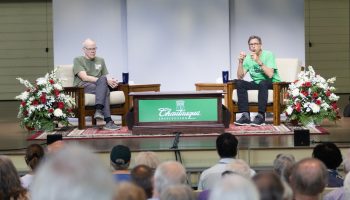Column by Kimberly Hamlin
In 1782, in his book Letters from an American Farmer, Hector St. John de Crèvecœur became the first person to ask and answer the question “What is an American?” As a Frenchman living in New York on the eve of the American Revolution, Crèvecœur had a bird’s eye view of American identity as it cohered. To Crèvecœur, what stood out about America was that “the rich and the poor are not so far removed from each other as they are in Europe. Some few towns excepted, we are all tillers of the earth … all respecting the laws, without dreading their power, because they are equitable.” Crèvecœur prophesied that “here individuals of all nations are melted into a new race of men, whose labours and posterity will one day cause great changes in the world.”
Yes and no. Crèvecœur’s definition of American identity was more aspirational than true even when he penned it in the 1770s. The greatest bar to this aspirational vision of America was intergenerational slavery. On July 5, 1852, the abolitionist leader Frederick Douglass asked a standing-room only audience in Rochester, “What, to the American slave, is your Fourth of July?” Douglass challenged his mostly white audience to reflect upon the significance of inviting him, a man who had escaped from slavery, to deliver their annual Fourth of July oration. According to Douglass, the Fourth of July was “a day that reveals to (enslaved people), more than all other days in the year, the gross injustice and cruelty to which he is the constant victim.”
This Fourth of July, we might also ask, what does our national holiday mean to those whom globalization has left behind, to the disenfranchised and to the incarcerated? With income inequality at a record high, the world’s largest population of incarcerated people (who are disproportionately descended from enslaved people) and unprecedented ideological divides, what does the American Dream mean in 2018?
Week Two’s diverse line-up of speakers and events will help us think through the complexities and contradictions of American life and maybe even illuminate a way forward. On their recent trips to small towns and cities, what have James and Deborah Fallows learned about America?
Through his award-winning writing at The New Yorker, Jelani Cobb has revealed the deep roots of systemic racism in our culture. His most recent essay (“Juneteenth and the Detention of Children in Texas”) points out America’s long history of separating children of color from their parents. In what other ways are the histories of slavery, immigration and incarceration intertwined?
We might also ask, where are the women in our shared historical narratives? Whose histories do we celebrate and whose do we forget? In her book Prairie Fires, Caroline Fraser reveals that even the few American women whom we thought we did know — in this case, Laura Ingalls Wilder — have been obscured by layers of family history and a broader culture that prioritizes the achievements of men.
Beginning with an elegiac description of indigenous people and their lands — the very land “settled” by the Ingalls family — Fraser also reminds us of the importance of perspective. Taína Caragol, a curator at the National Portrait Gallery, has helped make our national perspective more accurate by showcasing more Latino historical figures and artists at the museum. What is the relationship between historical commemorations and current political representation?
Week Two’s speakers will also teach us how to engage more productively in civil discourse about what it means to be American. Jelani Cobb will teach a master class on Tuesday, July 3 during the afternoon and at 3:45 p.m., President Eileen Aranda and Vice President David Carter from Claremont Lincoln University will lead a workshop on civil dialogue.
Thursday’s speakers — David Brooks, the conservative columnist for The New York Times, and John Halpin, senior fellow at the Center for American Progress — represent opposing ideological views. How does the nation look from their divergent perspectives, and where can we see common ground?
Since Crèvecœur first attempted to define American identity in the 1770s, we have been debating what precisely it means to be American. Over the past 250 years, what has united us is not that we have agreed. Rather, we have been united by our shared aspiration to be the sort of nation described by Crèvecœur — a nation where everyone is equal under the law, where oligarchs and their children have no more purchase on laws than anyone else, and where citizens engage in robust dialogue.
In recent years, as countless studies have shown, we have slowly lost this aspiration and this ability. As a result of what one sociologist named “the big sort,” most of us no longer even encounter those with whom we disagree or whose life experiences vary widely from our own.
Week Two at Chautauqua offers us the increasingly rare opportunity to seek out diverse perspectives and practice robust civic dialogue, both here and beyond. I look forward to discussing “American identities” throughout the week and especially during the post-lecture discussions that I will lead following the Thursday and Friday morning speakers. I am even more excited to see what plans and dreams emerge from our talks about American identity in the 21st century.
Kimberly Hamlin is associate professor of American studies and history at Miami University in Oxford, Ohio where she teaches a class on “The American Dream.” A current National Endowment for the Humanities Public Scholar, Hamlin contributes to The Washington Post’s Made by History column and is a member of the Ohio Humanities Council’s Speakers Bureau. She is one of three Miami faculty on the grounds during the 2018 season as part of a pilot Faculty Fellow program made possible by a philanthropic gift aiming to expand dialogue beyond the confines of Chautauqua in the tradition of the Chautauqua movement as envisioned by its founders. Hamlin will lead post-10:45 a.m. lecture conversations at 12:30 p.m. Thursday and Friday in the Hurlbut Church sanctuary.




